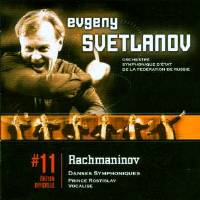
Breathtaking Poetry
Svetlanov conducts Rachmaninov -
reviewed by
HOWARD SMITH'... Svetlanov's affinity with Rachmaninov's daring idioms is always apparent.'
|

|
The Symphonic Dances Op 45 (1940) -- originally known as 'Fantastic Dances' -- is Rachmaninov's final work; within the 3 movements it distils his compositional output quoting from several earlier works; notably the poorly received 1st Symphony (1897) in the opening 'non allegro' and 'Dies Irae' (Death) plus 'All night Vigil' -- Resurrection (1915) during its finale. The intervening second movement (andante co moto) is a haunting view of years from the turn of the century to the 1917 Revolution.
Though the work was dedicated to and premièred by Eugene Ormandy and the Philadelphia Orchestra a four-handed transcription was ready by 10 August 1940, and less than three weeks later, on 29 August, the score was complete. It was premièred by Ormandy with the Philadelphia Orchestra in January 1941.
Rachmaninov's original scoring for two pianos has notable recorded advocates; duos Vladimir Ashkenazy and André Previn (Decca 1978), Nikolai Demidenko and Dmitri Alexeev (Hyperion 2005) and Martha Argerich with Alexandre Rabinovitch (Teldec 1992).
Whether in a piano version or for full orchestra, 'Symphonic Dances' is something of a misnomer, for despite its three-movement structure and shifting perspective, the work is progressive rather than episodic. Its involving character is symptomatic of life -- a dance of adventure, endeavour and ultimate philosophical shadows. The moods are exhilarating, yearning, romantic, despairing and Slavic to the core. It combines energetic rythmns, disciplined thematic development and Rachmaninov's trademark opulence and emotive melodies; composed in the USA, yet essentially Russian.
The zenith of the Symphonic Dances is found in its third movement, where the 'Dies Irae' motif, symbolising Death, is superceded by a Russian Orthodox chant, 'Blagosloven Yesi, Gospodi' ('Blessed art thou, O Lord' from Rachmaninov's Vespers Op 37 No 9). At this point he wrote 'Hallelujah', signifiying God's victory of Resurrection over Death and Rachmaninov's eventual embracement of the Church.
Svetlanov said of Symphonic Dances, completed four years after the 3rd Symphony (1936), 'I am utterly convinced that we should consider the work as Rachmaninov's 4th Symphony', and his reading here reflects that belief
[listen -- track 1, 0:00-1:58].
Continue >>
Copyright © 21 August 2007
Howard Smith, Masterton, New Zealand

|

